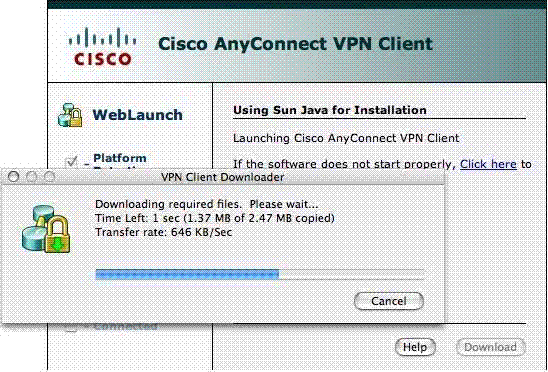| Click here to return to the '10.6: Save Cisco IPSec password in the Keychain' hint |
Logging In With the Cisco AnyConnect Client. Depending on how your company configured Duo authentication, you may or may not see a “Passcode” field when using the Cisco AnyConnect client. Single Password with Automatic Push. If AnyConnect only prompts for a password, like so. Using Duo With a Hardware Token. Hardware tokens are the most basic way of authenticating. To authenticate using a hardware token, click the Enter a Passcode button. Press the button on your hardware token to generate a new passcode, type it into the space provided, and click Log In (or type the generated passcode in the 'second password' field). Filiae maestae jerusalem translation. Using the 'Device:' drop-down menu to select. Create a new generic password entry in Keychain Access called 'WHATEVERAnyConnectVPN' (the name in Keychain access must match that in line 39 below) with your password for the Cisco AnyConnect VPN server. Open this script in Script Editor (both this and the above are in the Applications-Utilities.
I can't find a IPSec XAuth Password entry in my keychain for my Cisco VPN in Snow Leopard. I only find the IPSec Shared Secret in my keychain.
When I connect it does not save my user password, it always says 'server will prompt for password' and it does not create a keychain item for my user password (only the shared secret). Any idea how to get it to save my password?
One way around this is to install vpnc as an alternative (see this hint, but I haven't tested if this works with Snow Leopard yet.
I've been using Shimo for some time now as an alternative front end to the awful Cisco VPN GUI and it always remembers my password. Maybe I'll just keep using it now that it has been updated for Snow Leopard. I was kind of hoping to avoid installing any 3rd party VPN software and stick with Apple's built in VPN support though. I've noticed that the Leopard Cisco VPN implementation keeps asking me for my password every few hours which is a bit of a pain. Anyways, thanks for the reply.
This isn't Apple's fault. Screen recorder for mac os x 10 6 8. The Cisco VPN Concentrator, PIX, or ASA to which you are connecting is probably configured to disable password saving. If the client software is designed to Cisco specs, nothing you do will enable it to save your password if the VPN server prohibits it.
The Cisco IPSec client in iPhone OS 2 was broken in such a way that it would save the password. This was fixed in iPhone OS 3, and the same fix seems to incorporated in the Mac OS 10.6 IPSec client.
Sorry to disappoint, but after all the whole point of VPN is private network security.
---
Chip Old
BCPL.NET Internet Services
Just to let you know, Shimo will apparently ignore the server's request to always prompt the user for a password and use the password stored in the keychain. I guess this is technically a 'bug' although I'm sure most Shimo users want to keep it that way.
By default, Keychain Access only shows you your own keychain. If you click the expand button (triangle inside a square) at the bottom left corner of the Keychain Access window, you can show other keychains, including the System keychain. Once you're looking at the System keychain, the item you want has a Name matching your VPN, and its Kind is 'IPSec XAuth Password'. You can find it by sorting by Kind.
An easier alternative (from here) is simply to type 'xauth' in the search box at the top right corner of the Keychain Access window. (This works even if you don't have the Keychain list expanded and aren't looking at the System keychain.)
Then you can follow the rest of the instructions above to allow configd to access the password.

Has anyone found a way to import the cisco PCF file which stores the shared secret? Having our IT support group type in the shared secret manually doesn't seem like a sustainable option.
So, far it doesn't support import of .pcf files. There is a way to save OS X network configs to text files similar to a .pcf. I don't know if there is any ability to encrypt the password.
Even better though is that you can use a cert. If your organization has a cert your admin can put that on their machine in a secure way then use the above option to add an appropriate vpn config that uses the cert.
I found my problem. Apple once again half-assed a 'feature', it doesn't seem to support IPSec over UDP, only IPSec over TCP.
Now I've had TWO jobs over nine years..both use the same thing and Apple has had countless updates where VPN was mentioned, yet somehow this one stinkin' connection method just doesn't make it out of their hallowed halls. Bit dissapointed.
Oh and I had to go out and find the 'latest' cisco client to install just because the install broke my old one.
Others I know have simply reinstalled the version they had and didn't need the latest version. They were all on some variant of 4.9.
I opened the file in textedit and manually entered the data into the fields.
What file did you open? I'm having the same problem as the first commenter. I don't see IPSec XAuth Password in my Keychain Access under system. Thus, I am not able to modify anything.
Wow. What nitwit thought that my VPN would be more secure if they made me type my password every time? Gpg4usb mac download. I really thought I was screwed by the 'no UDP' support thing, but it was really just that 'TQrV9yo8varLjI' was too difficult for me to type with _no_ visual feedback. What bonehead thought that you should not be allowed to see while you are typing your password? It's not like it will be left around in my teletype printout.. And why, oh why, would they think that disabling paste would make things more secure? I wrote my password down anyways in the keychain -- so disabling paste didn't stop me from writing it down.
The upshot is, I've changed my password to the shortest, simplest phrase that will be accepted as a password, surely totally defeating the purpose of having a VPN in the first place.
Seems to me that the mentioned setting in Keychain is lost when you log out. Can anyone confirm this?
Just to let you know, Shimo will apparently ignore the server's request to always prompt the user for a password and use the password stored in the keychain. I guess this is technically a 'bug' although I'm sure most Shimo users want to keep it that way.
This does not work with 10.6.1. I set the password in keychain to allow all applications to access it, but it was still deleted upon connection, and restoring a copy of it did not make the client refer to it later. If this did work in 10.6.0, then maybe I can revert the client.
This is stupid, because Cisco's own client saves my password. The idea that you can enforce client behavior from the server is ludicrous. If your security depends on that, you're in trouble.
I'll get a saved password solution, but I'd rather use the integrated client.
I agree..This tip does not work on 10.6.1.
works for me in 10.6.2
http://code.google.com/p/shimogpl/
but I went with vpnc, which can now be successfully installed on Snow Leopard from Macports. Either way, no retyping required.
One more annoyance worked around.
Cisco Anyconnect Keychain Windows 10
I confirm it works with SL 10.6.4.
Nice! Thank you. This corrected the problem on 10.6.6.
Thanks! Works on my 10.6.7.
Cisco Anyconnect Vpn Client Download
This trick doesn't work with Lion anymore.
The XAuth password doesn't show in Keychain anymore, but somehow I managed to get it appear for a little while (irreproducible unfortunately) but even then this trick won't work.
Anyone who knows a solution for Lion?
